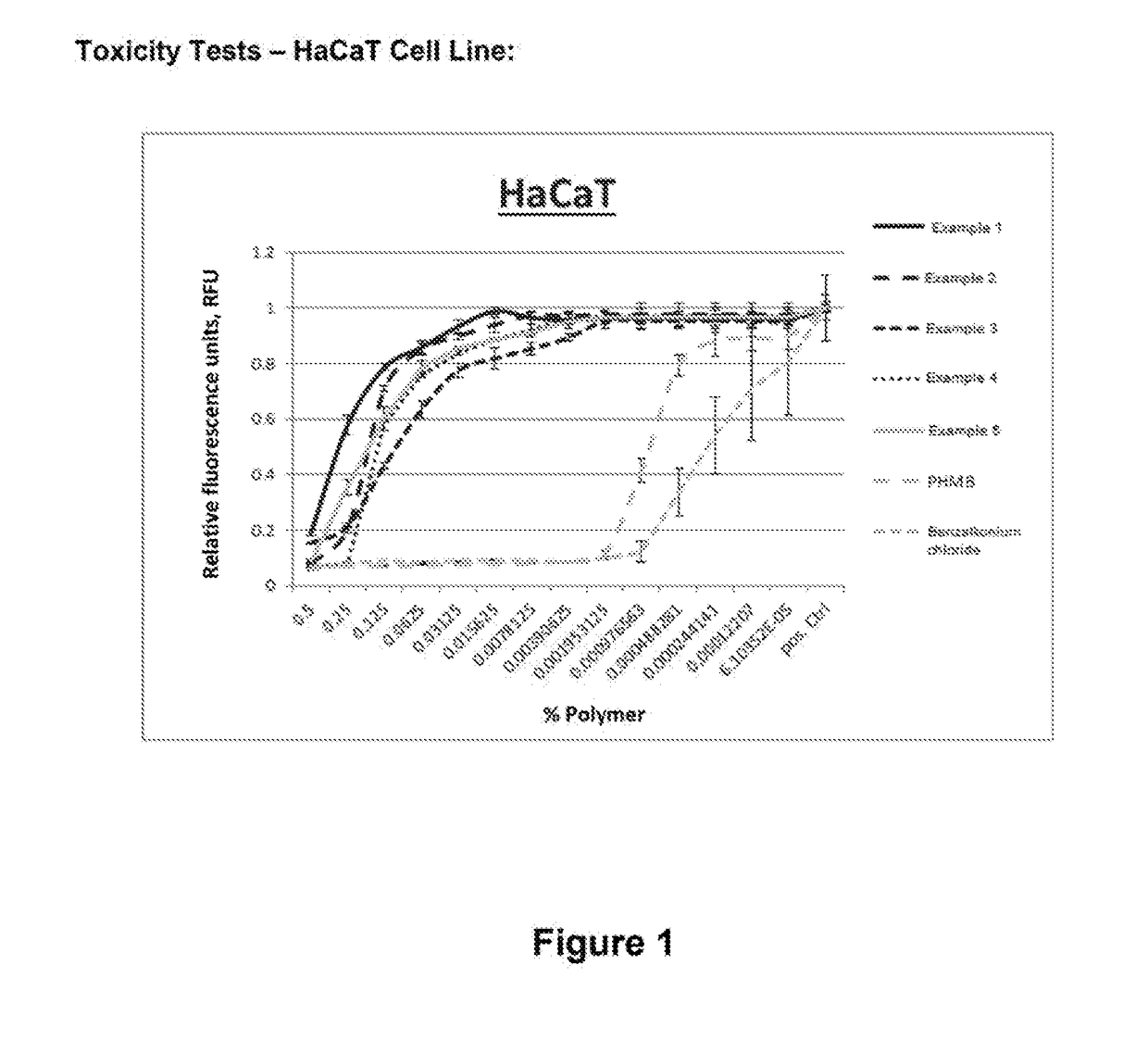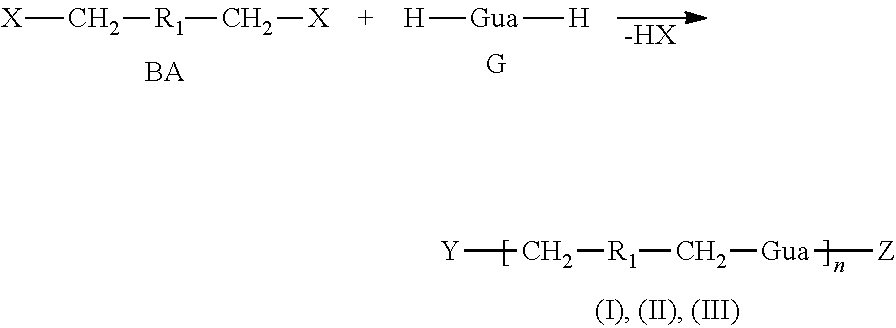Method for producing polyguanidines
a polyguanidine and polyguanidine technology, applied in the direction of antibacterial agents, paints with biocides, drug compositions, etc., can solve the problems of non-negligible toxicity of aminoguanidine compounds, toxicity that cannot be completely satisfied regarding antimicrobial effectiveness or toxicity, etc., to achieve clear biocidal activity, better antimicrobial activity, and even lower toxicity
- Summary
- Abstract
- Description
- Claims
- Application Information
AI Technical Summary
Benefits of technology
Problems solved by technology
Method used
Image
Examples
example 1
[0060]Preparation of Polyaminoguanidine (1)
[0061]α,α′-Dichloro-p-xylene (880 mg, 5.03 mmol) and 1.95 equivalents of aminoguanidine hydrochloride (1083 mg, 9.80 mmol) were heated with stirring to 160° C. for 3 h in an open reaction vessel, followed by heating to 180° C. for 2 h. After the reaction mixture had cooled to below 80° C., the tenfold amount of water was added to the reaction product, and after thoroughly mixing by means of stirring or ultrasound treatment, a clear, light yellow solution with traces of solid contents was obtained. It was filtered through a 0.2 μm PFTE membrane and then evaporated to obtain polyguanidine (1) as a yellow, amorphous solid.
[0062]For analysis, a sample was dissolved in a tenfold amount of D2O. When recording the 1H and the 13C NMR spectra, DSS (4,4-dimethyl-4-silapentane-1-sulfonic acid) was added for reference as an internal standard:
[0063]1H NMR (D2O), δ (ppm): 3.72-3.91 (ad, CH2A—N(Gua)-CH2A, JA,B=12.4 Hz, CH2A chain), 3.934.05 (as, CH2—NH-Gu...
example 2
Preparation of Polyaminoguanidine (2)
[0067]
[0068]In analogy to Example 1, polyguanidine (2) was prepared from α,α′-dichloro-m-xylene and aminoguanidine hydrochloride, yielding a yellowish, amorphous, completely water-soluble solid.
[0069]1H NMR (D2O), δ (ppm): 3.73-3.92 (ad, CH2A—N(Gua)-CH2A, JA,B=12.7 Hz, CH2A chain), 3.94-4.05 (as, CH2—NH-Gua, CH2 terminal), 4.10-4.23 (ad, CH2B—N(Gua)-CH2B, JA,B=12.7 Hz, CH2B chain), 4.29-4.38 (m, CH2A α-Gua), 4.45-4.53 (m, CH2B α-Gua), 7.23-7.85 (m, ═CH Ar), 8.10 (as, N═CH).
[0070]13C NMR (D2O), δ (ppm): 46.36, 46.66, 47.01 (CH2 α-Gua), 57.01, 57.04, 57.12, 57.14 (CH2 terminal), 63.94 (CH2—N(Gua)-CH2 chain), 129.63, 129.75, 130.09, 130.20, 130.83, 131.38, 131.44, 131.53, 131.57, 131.67, 131.82, 131.89, 132.18, 132.34, 132.73, 133.52, 134.23, 134.52, 135.29 (CH Ar), 135.72, 135.81, 136.12, 138.59, 138.69, 138.73, 139.13, 139.77, 139.90, 140.30 (Cq Ar), 151.24 (N═CH), 157.67, 159.78, 159.81, 160.86 (Cq Gua).
[0071]The NMR signals in the ranges of 3.73...
example 3
Preparation of Polyamino Guanidine (3)
[0073]
[0074]In analogy to Example 2, polyguanidine (3) was prepared from 132 mg (0.5 mmol) of α,α′-dibromo-m-xylene (instead of the dichloro derivative) as well as 1.75 equivalents of aminoguanidine hydrochloride (97 mg, 0.88 mmol), yielding a brownish, amorphous, water-soluble solid.
[0075]1H NMR (D2O), δ (ppm): 3.63-3.95 (m, CH2A—N(Gua)-CH2A, CH2A chain), 3.95-4.08 (as, CH2—NH-Gua, CH2 terminal), 4.13-4.24 (ad, CH2B—N(Gua)-CH2B, JA,B=12.5 Hz, CH2B chain), 4.31-4.40 (m, CH2A α-Gua), 4.47-4.55 (m, CH2B α-Gua), 7.17-7.86 (m, ═CH Ar), 8.12 (as, N═CH).
[0076]13C NMR (D2O), δ (ppm): 46.38, 46.64, 46.99 (CH2 α-Gua), 56.98, 57.11, 57.48 (CH2 terminal), 63.90 (CH2—N(Gua)-CH2 chain), 128.58, 129.08, 129.64, 129.76, 130.05, 130.20, 130.81, 130.98, 131.35, 131.41, 131.51, 131.71, 131, 80, 131.87, 132.16, 132.33, 132.69, 133.49, 134.21, 134.51, 135.29 (CH Ar), 135.66, 135.76, 136.06, 138.68, 138.98, 139.07, 139.25, 139.72, 139.85, 140.25 (Cq Ar), 150.46, 151...
PUM
| Property | Measurement | Unit |
|---|---|---|
| temperature | aaaaa | aaaaa |
| temperature | aaaaa | aaaaa |
| temperature | aaaaa | aaaaa |
Abstract
Description
Claims
Application Information
 Login to View More
Login to View More - R&D
- Intellectual Property
- Life Sciences
- Materials
- Tech Scout
- Unparalleled Data Quality
- Higher Quality Content
- 60% Fewer Hallucinations
Browse by: Latest US Patents, China's latest patents, Technical Efficacy Thesaurus, Application Domain, Technology Topic, Popular Technical Reports.
© 2025 PatSnap. All rights reserved.Legal|Privacy policy|Modern Slavery Act Transparency Statement|Sitemap|About US| Contact US: help@patsnap.com



